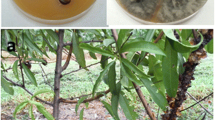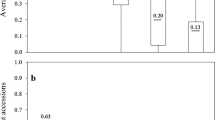Summary
Over the last 30 years, six resistance alleles (Dm2, Dm3, Dm6, Dm7, Dm11 andDm16) located in two linkage groups, have contributed to the control of downy mildew in lettuce crops grown under protection (glass or polythene) in northern Europe. More recently, an as yet genetically uncharacterised resistance factor, R18, has also begun to assume importance. The occurrence of the various combinations of these resistance alleles that exist in commercial cultivars has been dictated by the pathotypes ofBremia lactucae used in their selection but also restricted by linkage in repulsion. In the UK, a pathotype ofB. lactucae insensitive to phenylamide fungicides, such as metalaxyl, emerged in 1978 and became prevalent throughout lettuce production areas in subsequent years. The specific virulence of this pathotype was identical to the previously described phenylamide sensitive pathotype NL10 and cultivars carryingDm11, Dm16 or R18 were resistant. Consequently, an integrated control strategy based on the utilisation of metalaxyl on cultivars carryingDm11 provided effective control in UK until 1987 when a new phenylamide insensitive pathotype began to cause problems. The specific virulence of this second pathotype, which was first reported in the Netherlands and France, was identical to the previously described phenylamide sensitive pathotype NL15. Cultivars carryingDm6, Dm16 or R18, but notDm11, were resistant to NL15; consequently an appropriate change in the cultivar recommendations for use in the integrated control strategy was successfully promulgated. It is predicted that variations of this integrated control strategy involving the use of appropriately selectedDm gene combinations may prove effective for some time. This prediction is based on studies of the status of the avirulence loci in the two phenylamide insensitive pathotypes and of the specific virulence characteristics of phenylamide sensitive components of the pathogen population.
Similar content being viewed by others
References
Blok, I. & A.H., Eenink, 1974.Bremia in latucae sorten, in het bijzonder inL. sativa. Zaadbelangen 28: 138–40.
Blok, I. & J.J.M. Van Bakel, 1976. Wit in sla. Groenten en Fruit. No. 31638, 172.
Blok, I. & Van Der, Schaf-Van Waadenooyen, Kernekamp, 1977. Problemen rondBremia in sla. Zaadbelangen 31: 57–58, 60.
Crute, I.R., 1987. The occurrence, characteristics, distribution, genetics and control of a metalaxyl-resistant pathotype ofBremia lactucae in the United Kingdom. Plant Disease 71: 763–767.
Crute, I.R., 1989. Lettuce downy mildew: a case study in integrated control. In: K.J., Leonard & W.E., Fry (Eds.) Plant Disease Epidemiology Vol. 2, pp. 30–53. McGraw-Hill, New York.
Crute, I.R., 1991. Downy mildew of lettuce. In: A.N., Mukhopadhyay, H.S., Chaube, J., Kumar & U.S., Singh (Eds.) Plant Diseases of International Importance Vol. II, pp. 165–185. Prentice Hall, New Jersey.
Crute, I.R., 1992. From breeding to cloning (and back again?): a case study with lettuce downy mildew. Ann. Rev. Phytopathol. 30: 485–506.
Crute, I.R. & J.M., Harrison, 1988. Studies on the inheritance of resistance to metalaxyl inBremia lactucae and on the stability and fitness of field isolates. Plant Pathol. 37: 231–250.
Crute, I.R., J.M., Norwood & P.L., Gordon, 1987. The occurrence, characteristics and distribution in the United Kingdom of resistance to phenylamide fungicides inBremia lactucae (lettuce downy mildew). Plant Pathol. 36: 297–315.
Eenink, A.H. & I., Blok, 1980. Valse meeldauw in sla. Zaadbelangen, 34: 46–48.
Eenink, A.H., I., Blok & R., Groenwold, 1983. Onderzoek van de relatie tussenLactuca enBremia lactucae. Verslag van een voorlichtingsbijeenkomst voor slaveredelaars. Zaadbelangen 37: 95–96.
Farrara, B.F., T.W., Ilot & R.W., Michelmore, 1987. Genetic analysis of factors for resistance to downy mildew (Bremia lactucae) in species of lettuce (Lactuca sativa andL. serriola). Plant Pathol. 36: 499–514.
Groenwold, G. 1978. HetBremia probleem in sla. Zaadbelangen 32: 132–134.
Hulbert, S.H. & R.W., Michelmore, 1985. Linkage analysis of genes for resistance to downy mildew (Bremia lactucae) in lettuce (Lactuca sativa). Theor. Appl. Genet. 70: 520–528.
Jagger, I.C. & T.W., Whitaker, 1940. The inheritance of immunity from mildew (Bremia lactucae) in lettuce. Phytopathology 30: 427–433.
Kesseli, R.V., I., Paran & R.W., Michelmore, 1990. Genetic map of lettuce (Lactuca sativa, 2N=18). In: S.J., O'Brien (Ed.) Genetic Maps, pp. 6.100–102. Cold Spring Harbor Press, New York.
Landry, B.S., R.V., Kesseli, B., Farrara & R.W., Michelmore, 1987. A genetic map of lettuce (Lactuca sativa L.) with restriction fragment length polymorphism, isozyme, disease resistance and morphological markers. Genetics 116: 331–337.
Leroux, P., B., Maisonneuve & Y., Bellec, 1988. Detection en France de souches deBremia lactucae, agent du mildiou de la laitue, resistantes au metalaxyl et a l'oxadixyl. P.H.M. Revue-Horticole 292: 37–40.
MacPherson, N.J., 1932. The cultivation of lettuce under glass with special reference to varieties resistant to downy mildew. J. Min. Agric. (Lond.) 38: 998–1003.
Norwood, J.M. & I.R., Crute, 1980. Linkage between genes for resistance to downy mildew (Bremia lactucae) in lettuce. Ann. appl. Biol. 94: 127–135.
Rodenburg, C.M., 1975. Identificatie onderzoek bij sla. Zaadbelangen 29: 319–321.
Rodenburg, C.M. & J.A., Huyskes, 1962. Ten years of Dutch lettuce breeding. Grower 57: 300–301.
Schettini, T.M., E.J., Legg & R.W., Michelmore, 1991. Insensitivity to metalaxyl in California populations ofBremia lactucae and resistance of Californian lettuce cultivars to downy mildew. Phytopathology 81: 64–70.
Schultz, H. & K., Röder, 1938. Die Anfälligkeit verschiedener Varietäten und Sorten von Salat (Lactuca sativa L. undLactuca serriola L.) gegen den Falschen Meltau (Bremia lactucae Regel). Züchter 10: 185–194.
Tjallingii, F. & C.M., Rodenburg, 1967. Onderzoek van slarassen op vatbaarheid voor drie fysio's van valse meeldauw (Bremia lactucae). Zaadbelangen 21: 104–105.
Tjallingii, F. & C.M., Rodenburg, 1969. Onderzoek van slarassen op vatbaarheid voor vier fysio's van valse meeldauw. Zaadbelangen 23: 436–438.
Whitaker, T.W., G.W., Bohn, J.E., Welch & R.G., Grogan, 1958. History and development of head lettuce resistant to downy mildew. Amer. Hort. Soc. Sci. Proc. 72: 410–416.
Author information
Authors and Affiliations
Rights and permissions
About this article
Cite this article
Crute, I.R. The role of resistance breeding in the intergrated control of downy mildew (Bremia lactucae) in protected lettuce. Euphytica 63, 95–102 (1992). https://doi.org/10.1007/BF00023915
Issue Date:
DOI: https://doi.org/10.1007/BF00023915




